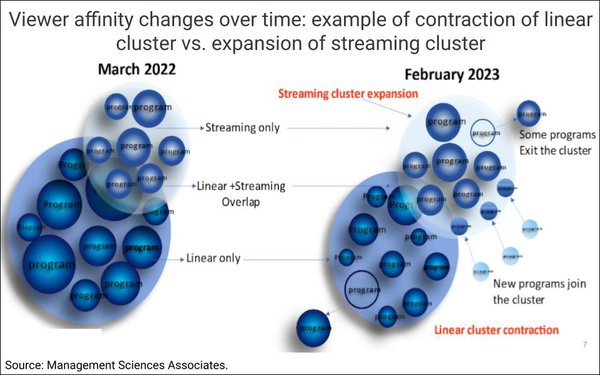In recent years, a veritable locust storm of new video content has descended on the TV landscape, vastly broadening consumer viewing options. One could argue that we’ve entered a Platinum Age
of Television, given the variety of choice and multitude of ways to watch this video content. Many consumers continue to demand and are willing to pay for premium fare, despite the specter of
recession.
For many content programmers, however — including giants such as Netflix, Disney, Amazon and Paramount and moderately-sized entities like AMC and Crown — recouping hefty
production investments is increasingly challenging. All are in head-to-head competition for viewers’ attention.
Studios seek out a combination of content themes and casting that have
potential for audience traction based on popularity of personalities, entertainment genre, social media and TV viewing trends, for example. Many programs are pilot-tested but predicting how a
show or movie will engage with an audience is a challenging undertaking.
advertisement
advertisement
After video content has been released for viewing, programmers are tasked with cultivating an audience. For TV
shows appearing in the linear space, this routinely involves scheduling shows in time slots where viewers are most prone to sample new entrants — perhaps adjacent to popular programs within
their own content line-ups or on competing networks that will accept promotional ads. Promotional advertising may be deployed to drive awareness and trial. It’s also used to spark on-demand
viewing of streaming content where no time schedule anchor exists for attracting viewers.
Once these steps are taken, programmers hope new viewers will arrive and that some will remain as a
loyal audience base who will potentially spread the word to others. For content that stands the test of time, there exists an afterlife of licensing and re-runs that actually comprise the bulk of all
TV programming. In the 1980’s, many start-up cable networks infused their proprietary content with off-network reruns. FAST channels are repeating this pattern in today’s streaming
environment.
Today’s fractionalization and the nomadic behavior of TV audiences pose a serious challenge for traditional post-launch scheduling and promotional
strategies designed to attract viewers.
Linear audiences, who might be influenced by promotional ads, continue to dwindle. The most-viewed time slots are sports and other event-oriented fare.
Traditional viewing patterns continue to crumble as consumers traverse across linear channels, Amazon, Netflix and FAST outlets such as Pluto, Fubo and Crackle.
The focus on attracting viewers
with tent-pole programs must be balanced with the reality that most video content draws moderately-sized audiences. How many “Yellowstones” are on the production horizon compared to
niche-appeal shows? How many past hit series, beyond “The Office” and “Friends,” can continue to attract substantial audiences year after year?
In the practical
everyday business of transacting ad impressions, both buyer and seller desire to mitigate the risk that comes with achieving audience delivery guarantees by reaching desired consumer segments anywhere
they happen to be within a splintering viewing universe.
Affinity Analytics
Perhaps the most promising tool for navigating the linear-to-streaming chasm
is affinity analytics — a data science technique for defining clusters of viewers with a penchant for watching certain program genre types such as sports, documentaries, finance and
entertainment.
Affinity analysis can help content programmers understand, cultivate and retain audiences by identifying viewers of like affinity. Finding other types of content that
“Program A” viewers are consuming, for example, can be used to inform “Program A” scheduling and promotional decisions.
Some of you may be familiar with this approach,
as it has been widely used to evaluate linear audiences for some time. But in today’s complex viewing environment, cluster relationships are likely to change more rapidly over time, impacted by
popularity trends and the disruption in viewing habits, including toggling between linear and streaming mediums, and affinity analysis can incorporate all of this. It now makes sense to put
affinity analysis to work across linear and streaming content to help programmers improve profitability of their content strategies.
Crossing the Linear-to-Streaming Chasm
The hypothetical affinity analysis shown below, based on licensed data sources for both streaming and linear TV, shows how the cluster of streaming programs expanded during the course of a year,
with new programs joining and others departing. During the same timeframe, the linear sphere declined moderately.
Overlap programs — those watched in both linear and streaming —
may be valuable for informing promotional ad-spend strategies, since viewers are present in both spaces. And identifying and cultivating viewers who are heavily streaming-oriented, and rarely watch
linear TV, should help extend reach.

As TV audiences continue to splinter, affinity analytics can provide programmers a way to anticipate shifts in how and what consumers watch on TV while informing viewer retention strategies in both
linear and streaming universes. Improving retention would benefit brands by reducing the risk inherent in achieving consumer target audience guarantees within a highly dynamic viewing
environment.
The end game is for programmers to manage content strategies more efficiently by steadily monitoring audiences via affinity analytics and translating the insights to enhance
pre-and post-launch schedule placement and promotional ad strategies.